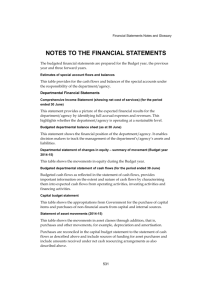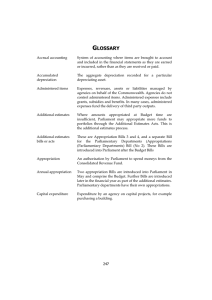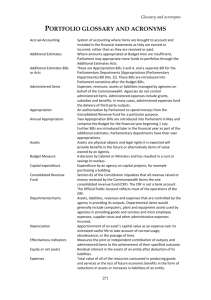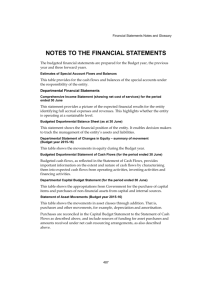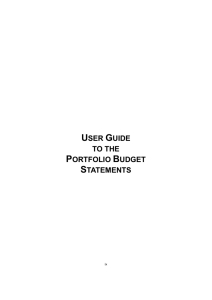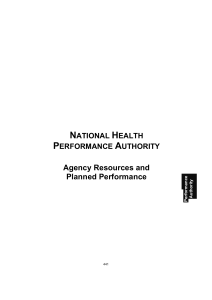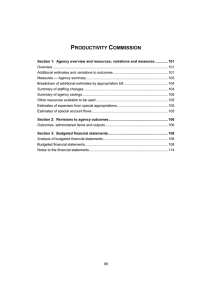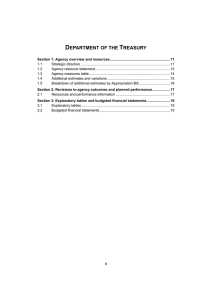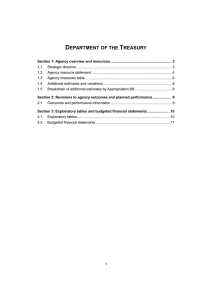Glossary
advertisement
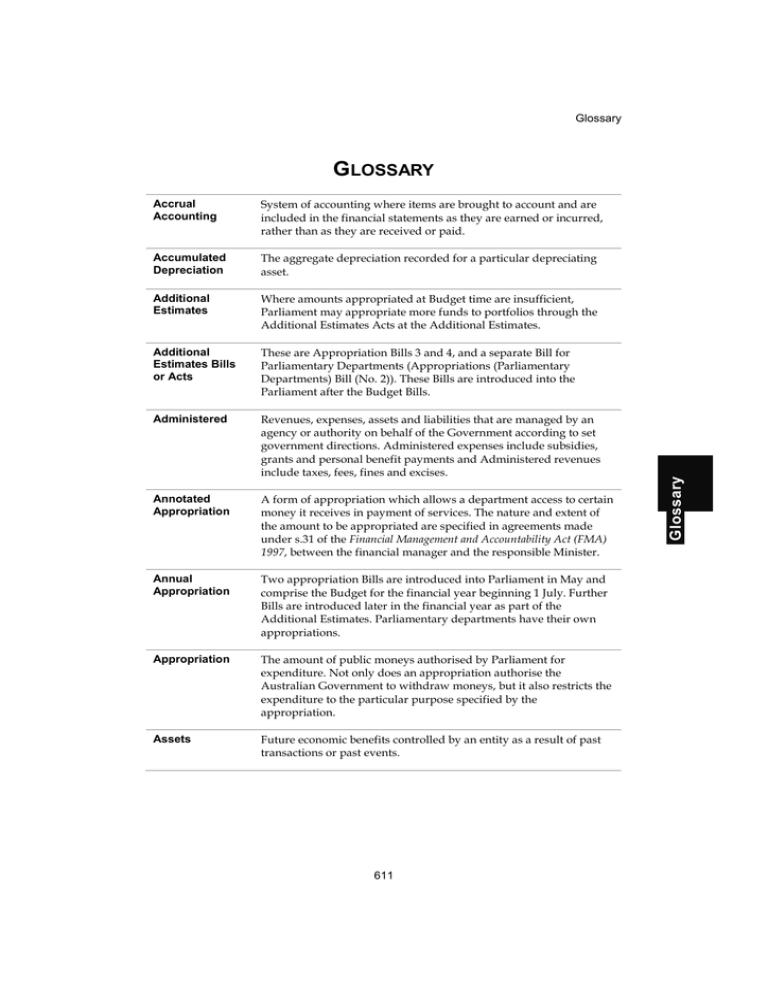
Glossary Accrual Accounting System of accounting where items are brought to account and are included in the financial statements as they are earned or incurred, rather than as they are received or paid. Accumulated Depreciation The aggregate depreciation recorded for a particular depreciating asset. Additional Estimates Where amounts appropriated at Budget time are insufficient, Parliament may appropriate more funds to portfolios through the Additional Estimates Acts at the Additional Estimates. Additional Estimates Bills or Acts These are Appropriation Bills 3 and 4, and a separate Bill for Parliamentary Departments (Appropriations (Parliamentary Departments) Bill (No. 2)). These Bills are introduced into the Parliament after the Budget Bills. Administered Revenues, expenses, assets and liabilities that are managed by an agency or authority on behalf of the Government according to set government directions. Administered expenses include subsidies, grants and personal benefit payments and Administered revenues include taxes, fees, fines and excises. Annotated Appropriation A form of appropriation which allows a department access to certain money it receives in payment of services. The nature and extent of the amount to be appropriated are specified in agreements made under s.31 of the Financial Management and Accountability Act (FMA) 1997, between the financial manager and the responsible Minister. Annual Appropriation Two appropriation Bills are introduced into Parliament in May and comprise the Budget for the financial year beginning 1 July. Further Bills are introduced later in the financial year as part of the Additional Estimates. Parliamentary departments have their own appropriations. Appropriation The amount of public moneys authorised by Parliament for expenditure. Not only does an appropriation authorise the Australian Government to withdraw moneys, but it also restricts the expenditure to the particular purpose specified by the appropriation. Assets Future economic benefits controlled by an entity as a result of past transactions or past events. 611 Glossary GLOSSARY Glossary Available Appropriation Available appropriation is used to allow a comparison of the current year’s appropriation with what was made available for use in the previous year. Available appropriation is the amount available to be drawn down, and is equal to: Budget appropriation + Additional Estimates appropriation + Departmental Items Adjustments and Borrowing + Advance to the Finance Minister – Savings – Rephasings. Average Staffing Level (ASL) The average number of employees receiving salary/wages (or compensation in lieu of salary/wages) over a financial year, with adjustments for casual and part-time employees to show the full-time equivalent. Budget Measure A decision by the Cabinet or Ministers that has been finalised since the Budget and has resulted in a change in expenditure in the current year and/or the forward years. See also Cross-portfolio Budget measure. CAC Act 1997 Commonwealth Authorities and Companies Act 1997. This Act regulates certain aspects of the financial affairs of Commonwealth authorities. In particular, it has detailed rules about reporting and accountability. This Act also deals with other matters relating to Commonwealth authorities, such as banking and investment and the conduct of officers. Capital Expenditure Expenditure by an agency on capital projects, for example purchasing a building. Consolidated Revenue Fund Section 81 of the Constitution stipulates that all revenue raised or money received by the Commonwealth forms the one consolidated revenue fund (CRF). The CRF is not a bank account. The Official Public Account reflects most of the operations of the CRF. Cross-portfolio Budget Measure This is a Budget measure which affects outcomes administered in a number of portfolios. Departmental Revenues, expenses, assets and liabilities in relation to an agency or authority that are controlled by the agency. Departmental expenses include employee and supplier expenses and other administrative costs, which are incurred by the agency in providing its goods and services. Depreciation Apportionment of an asset’s capital value as an expense over its estimated useful life to take account of normal usage, obsolescence, or the passage of time. Efficiency Dividend An annual deduction of a percentage of running costs from an agency’s budget, which acts as both an incentive to efficiency and a quantification of some of the efficiency gains made by an agency in the previous year. 612 Equity or Net Assets Residual interest in the assets of an entity after deduction of its liabilities. Expense Total value of all of the resources consumed in producing goods and services or the loss of future economic benefits in the form of reductions in assets or increases in liabilities of an entity. Fair Value Valuation methodology: the amount for which an asset could be exchanged, or a liability settled, between knowledgeable and willing parties in an arm’s length transaction. The fair value can be affected by the conditions of the sale, market conditions and the intentions of the asset holder. FMA Act 1997 Financial Management and Accountability Act 1997. The principal legislation governing the proper use and management of public money and public property and other Australian Government resources. FMA regulations and FMA Orders are made pursuant to the Act. Forward Estimates A system of rolling three year financial estimates. After the Budget is passed, the first year of the forward estimates becomes the base for next year’s Budget bid, and another outyear is added to the forward estimates. Historical Cost The original cost of acquisition of an asset, including any costs associated with acquisition. Under Australian Accounting Standards Board 116, Property, Plant and Equipment, assets are required to be reported initially at the cost of acquisition (historical cost). The Australian Government’s financial reporting requirements issued under the Finance Minister’s Orders require the revaluation of non current assets with sufficient regularity to ensure that the carrying amount of assets which does not differ materially from fair value as at reporting date. Liabilities Future sacrifices of economic benefits that an entity is presently obliged to make to other entities as a result of past transactions or other past events. Operating Result Equals revenue less expense. Outcomes Outcomes are the results of events, actions or circumstances, in particular, the impact of the Australian Government on the Australian community. Outcomes may be linked with both the Programs of agencies using the departmental expenses under their control, and with the administered expenses which agencies manage on behalf of the Australian Government. Planned outcomes represent the changes desired by Government. The achievement of actual outcomes is assessed and reported in agencies’ Annual Report. 613 Glossary Glossary Glossary Performance Indicators (Deliverables and Key Performance indicators) A concise list of indicators, which are used to measure agency efficiency and effectiveness in achieving the Government’s Outcomes. Indicators must be measurable and quantifiable to allow for consistent estimation over the Budget and forward years. Indicators in the Portfolio Budget Statements are reported against the Annual Report for the same year. Portfolio Budget Statements Statements prepared by portfolios to explain the Budget appropriations in terms of Outcomes and Programs. Program Commonwealth Programs deliver benefits, services or transfer payments to individuals, industry/business or the community as a whole and are primary vehicles for Government Agencies to achieve the intended results of their Outcome statements. Revenue Total value of resources earned or received to cover the production of goods and services. Special Account Balances existing within the Consolidated Revenue Fund (CRF) that are supported by standing appropriations (Financial Management and Accountability (FMA) Act 1997, ss.20 and 21). Special Accounts allow money in the CRF to be acknowledged as set-aside for a particular purpose. Amounts credited to a Special Account may only be spent for the purposes of the Special Account. Special Accounts can only be established by a written determination of the Finance Minister (s.20 FMA Act 1997) or through an Act of Parliament (referred to in s.21 of the FMA Act 1997). Special Appropriations (including standing appropriations) An amount of money appropriated by a particular Act of Parliament for a specific purpose and number of years. For special appropriations the authority to withdraw funds from the Consolidated Revenue Fund does not generally cease at the end of the financial year. Standing appropriations are a sub-category consisting of ongoing special appropriations — the amount appropriated will depend on circumstances specified in the legislation. Staff Years An aggregate measure of employment based on the hours worked by employees over the period of one year. It is the unit of measurement for staff resource use. Standing Appropriation Similar to special appropriations, except that instead of an amount being specified in the appropriation, the Act provides for an automatic payment of funds where an entitlement exists, such as age pensions, or for the Minister of Finance and Deregulation to determine an amount in accordance with specified criteria. The terms special and standing are often used interchangeably. 614 Financial Statements Notes FINANCIAL STATEMENTS NOTES The budgeted financial statements are prepared for the Budget year, the previous year and three forward years. Estimates of special account flows and balances This table provides for the cash flows and balances of the special accounts under the responsibility of the department/agency. Departmental Financial Statements Comprehensive Income Statement (showing net cost of services) (for the period ended 30 June) This statement provides a picture of the expected financial results for the department/agency by identifying full accrual expenses and revenues. This highlights whether the department/agency is operating at a sustainable level. Budgeted departmental balance sheet (as at 30 June) This statement shows the financial position of the department/agency. It enables decision makers to track the management of the department’s/agency’s assets and liabilities. Departmental statement of changes in equity – summary of movement (Budget year 2012-13) This table shows the movements in equity during the Budget year. Budgeted cash flows as reflected in the statement of cash flows, provides important information on the extent and nature of cash flows by characterising them into expected cash flows from operating activities, investing activities and financing activities. Capital budget statement This table shows the appropriations from Government for the purchase of capital items and purchases of non-financial assets from capital and internal sources. Statement of asset movements (2012-13) This table shows the movements in asset classes through addition (e.g. purchases) and other movements (e.g. depreciation and amortisation). Purchases are reconciled in the capital budget statement to the statement of cash flows as described above and include sources of funding for asset purchases and include amounts received under net cash resourcing arrangements as also described above. 615 Financial Notes Budgeted departmental statement of cash flows (for the period ended 30 June) Financial Statements Notes Schedules of Administered Activity Schedule of budgeted income and expenses administered on behalf of Government (for the period ended 30 June) The schedule identifies the revenues and expenses administered by the department/agency on behalf of the Government. Schedule of budgeted assets and liabilities administered on behalf of Government (as at 30 June) The schedule shows the assets and liabilities administered by the department/agency on behalf of the Government. Administered Capital Budget Statement (for the period ended 30 June) The schedule shows the cash flows administered by the department/agency on behalf of the Government. Schedule of budgeted administered cash flows (for the period ended 30 June) The schedule shows the cash flows administered by the department/agency on behalf of the Government. Statement of asset movements (2012-13) This table shows the movements in asset classes through addition (eg purchases) and other movements (eg depreciation and amortisation). Purchases are reconciled in the Capital Budget Statement to the Statement of Cash Flows as described above and include sources of funding for asset purchases. 616
